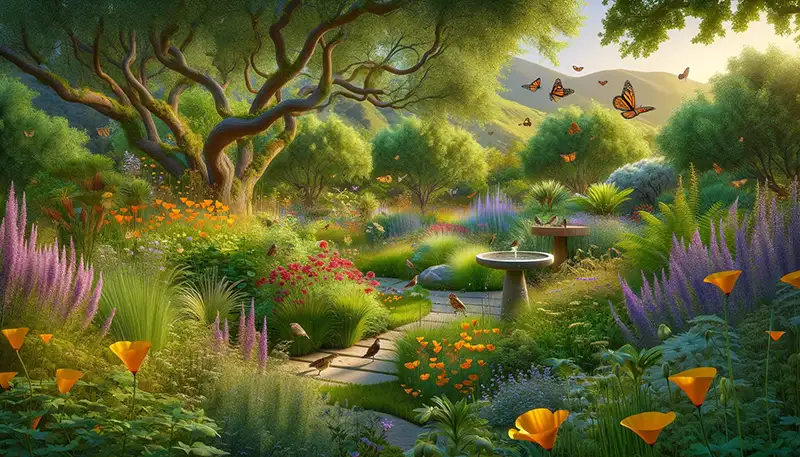
In the vibrant heart of Central California, amidst its urban sprawl and agricultural expanses, lies the potential for a quieter, more introspective revolution—one that returns a slice of wilderness to our backyards. Wildlife-friendly gardening is not just an act of horticultural interest but a commitment to restoring natural habitats in urban and suburban settings. This approach brings joy as well as benefits, from the sheer beauty of observing nature up close to the critical environmental boon of supporting local ecosystems.
Understanding Local Wildlife
Central California, a region of diverse habitats, from coastal areas to inland valleys, is home to an array of wildlife. Birds like the spirited Allen’s Hummingbird, majestic Great Horned Owl, and industrious Western Bluebird navigate these skies, while butterflies such as the Monarch and Painted Lady add splashes of color to the air. Beneficial insects, including bees and ladybugs, play pivotal roles in pollination and pest control. Understanding the specific needs of these species—what attracts them, what nourishes them—is key to creating a garden that not only beckons but sustains local wildlife.
Plant Selection for Wildlife
Native Plants
The foundation of a wildlife-friendly garden lies in its plant selection, with native plants taking center stage. These species have evolved alongside local wildlife and are intrinsically adapted to the region’s climate and soil, making them indispensable sources of food and shelter. For instance, the California Poppy (Eschscholzia californica) and Coast Live Oak (Quercus agrifolia) not only embellish the garden with their beauty but serve as vital resources for native fauna.
Seasonal Blooms
To ensure a continuous buffet for our winged and six-legged visitors, incorporating plants that bloom at different times throughout the year is crucial. Spring might see the blossoming of the Western Redbud (Cercis occidentalis), summer the vibrant display of the Purple Coneflower (Echinacea purpurea), and fall the rich hues of the California Fuchsia (Epilobium canum). Such planning ensures that wildlife has a consistent source of nourishment.
Water Features for Attracting Wildlife
Birdbaths and Ponds
Water, the essence of life, is a magnet for wildlife. A simple birdbath, a discreetly placed shallow dish, or a more elaborate pond can serve as a vital water source for birds, bees, and butterflies. Designing these features with gradual slopes or placing stones inside for easier access can make them both safe and inviting.
Maintenance Tips
Regular maintenance of these water features is essential to ensure they remain clean and safe for garden visitors. Refreshing the water supply and keeping the basins clean prevents the spread of diseases and keeps the water inviting.

Creating Shelter and Nesting Sites
Shrubs and Trees
Dense plantings of shrubs and trees not only add depth and texture to the garden but also offer crucial shelter and nesting sites. The Manzanita (Arctostaphylos spp.) and Toyon (Heteromeles arbutifolia) are excellent examples, providing dense foliage for birds to hide and nest in.
Man-made Structures
In addition to natural shelters, man-made structures like birdhouses, bat boxes, and insect hotels can offer safe havens for various species. Placing these structures in quiet, sheltered parts of the garden can help ensure they are used by the intended wildlife.
Chemical-Free Gardening Practices
To truly support wildlife, gardens must be havens not just in terms of food and shelter but also safety. This means eschewing pesticides and herbicides that can harm non-target species. Adopting organic gardening practices, such as companion planting and natural pest controls, protects the garden’s visitors and residents alike.
The Joy of Observation
Creating spaces for quiet observation and reflection allows us to engage with the garden’s wildlife on a profound level. Seating areas positioned with views of busy bird feeders or vibrant flowering plants can become stages for nature’s play, providing endless entertainment and educational opportunities.
Get Started
The practice of wildlife-friendly gardening in Central California represents a powerful tool for conservation, a step towards rekindling the area’s rich biodiversity. By transforming our gardens into refuges for local wildlife, we not only enhance our own lives with beauty and interest but also contribute to the broader ecological health of our region. Let’s each take action in our green spaces, no matter the size, and join in the collective effort to nurture and sustain the natural world at our doorstep.
To get help creating your own wildlife-friendly backyard, contact us today.
